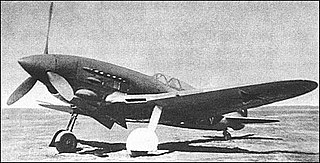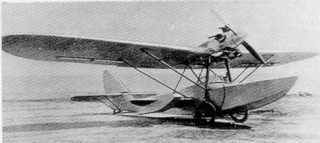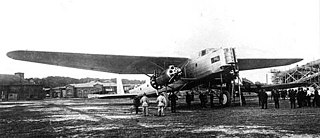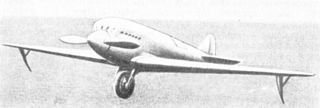
The Yakovlev Yak-3 was a single-engine, single-seat World War II Soviet fighter. Robust and easy to maintain, it was much liked by both pilots and ground crew. One of the smallest and lightest combat fighters fielded by any combatant during the war, its high power-to-weight ratio gave it excellent performance and it proved to be a formidable dogfighter.

The Yakovlev Yak-1 was a Soviet fighter aircraft of World War II. The Yak-1 was a single-seat monoplane with a composite structure and wooden wings; production began in early 1940.

The Yakovlev Yak-15 was a first-generation Soviet turbojet fighter developed by the Yakovlev design bureau (OKB) immediately after World War II. The main fuselage was that of Yakovlev Yak-3 piston-engine fighter modified to mount a reverse-engineered German Junkers Jumo 004 engine. The Yak-15 and the Swedish Saab 21R were the only two jets to be successfully converted from piston-power to enter production. 280 aircraft were built in 1947. Although nominally a fighter, it was mainly used to qualify piston-engine-experienced pilots to fly jets.

The Polikarpov ITP was a Soviet fighter prototype designed during World War II. Development was prolonged by the evacuation of the design bureau forced by the German advance on Moscow in the fall of 1941. By the time the second prototype was finished the Soviets had fighters with equivalent or better performance already in production and the program was cancelled.
The Ilyushin Il-102 was a Soviet experimental jet-powered ground-attack aircraft designed by Ilyushin. Once described as the "most gorgeously ugly combat jet ever," this aircraft was never chosen for production, being surpassed by the Su-25. Only a few development prototypes were built.

The Lavochkin-Gorbunov-Gudkov LaGG-3 was a Soviet fighter aircraft of World War II. It was a refinement of the earlier LaGG-1 and was one of the most modern aircraft available to the Soviet Air Force at the time of Germany's invasion in 1941. Despite its wooden construction, it was both overweight and underpowered. At one point in the war, on average 12 LaGG-3s were being completed daily and 6,528 had been built in total when Factory 31 in Tbilisi switched production to the Yak-3 in 1944.

The Shavrov Sh-2 was a 1930s Soviet amphibious sesquiplane flying boat developed from the Sh-1, with a more powerful engine, slightly increased size and amphibious undercarriage. The Sh-2 could carry three people including the crew.
The Tupolev ANT-9 was a Soviet passenger aircraft of the 1930s. It was developed as a reaction to the demand for a domestic airliner. At this time Deruluft, one of the forerunners of Aeroflot, flew only with foreign models, which were mainly German or Dutch.

The Polikarpov R-Z was a Soviet reconnaissance bomber aircraft of the 1930s. It was a revised version of the Polikarpov R-5 which was built in large numbers between 1935 and 1937. It was used in combat during the Spanish Civil War as well as the Winter War and Battle of Khalkhin Gol.

Tupolev acquired much experience in building his first two aircraft, which he employed for the next one, the ANT-3. By this time, Soviet Air Force leaders were convinced that metal was a highly usable substance in the building of airplanes. Tupolev therefore guided AGOS- TsAGI in creating the first Soviet all-metal aircraft. The ANT-3 was Tupolev's first practical aircraft.

The Polikarpov I-3 was a Soviet fighter designed during the late 1920s. It entered service in 1929, but was retired in 1935 with the advent of fighters with higher performance.

The Grigorovich TB-5 was an experimental heavy bomber designed and tested in the Soviet Union in the early 1930s. Designed as a competitor for the Tupolev TB-3, the TB-5 was intended to be powered by two FED 24-cylinder X engines of 746 kW (1,000 hp) each. When these were canceled, the underwing pods were revised to each house a pair of Bristol Jupiter engines in a push-pull configuration. Despite projected performance inferior to TB-3, it was hoped that TB-5 would gain an advantage by using less metal thanks to its mixed construction of fabric-covered metal frame.

The Polikarpov I-6 was a Soviet biplane fighter prototype of the late 1920s. It was designed with traditional wooden construction in comparison with the wood and steel tube construction Polikarpov I-5. Its development took longer than planned and the lead designer, Nikolai Polikarpov, was arrested for industrial sabotage, which only further delayed the project. Only two prototypes were built, as the I-5 was selected for production.

Polikarpov DI-1, also known as 2I-N1, Russian: Поликарпов ДИ-1 (2И-Н1), was a prototype Soviet two-seat fighter designed during the 1920s. The sole prototype built crashed on its ninth flight, due to manufacturing defects, and the program was cancelled.
The Nikitin NV-2 was a single-seat sporting aircraft produced in the USSR from 1935.

The Bartini Stal-6, was a single-engined experimental aircraft designed, built and tested in the USSR from 1930.

The Tupolev I-14 was a Soviet fighter aircraft of the 1930s. It was a single-engined, single-seat monoplane with retractable undercarriage, designed to carry heavy armament, and as such was one of the most advanced fighters of its time. It was ordered into production, but this was cancelled after only a small number had been built, the competing Polikarpov I-16 being preferred.
The Tupolev ANT-21 was a Soviet twin-engined four-seat heavy fighter, which also had the designation MI-3. It was not accepted for production, only two prototypes being built.
The Tupolev ANT-41 was a prototype Soviet twin-engined torpedo-bomber of the 1930s. A single prototype was built, which was destroyed in a crash. No production followed, with the Ilyushin DB-3 serving as a torpedo bomber instead.
The Polikarpov Ivanov was a 1930s prototype Soviet ground attack monoplane designed by Polikarpov for a soviet government procurement competition codenamed Ivanov.














